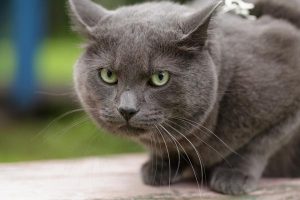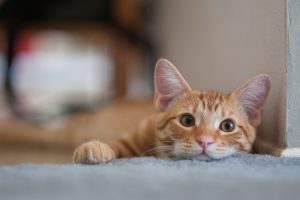Posts Tagged ‘cat urinary tract health’
Why Cats Spray And Mark In The House
 Ooh, that smell! That is the reaction when someone gets wind of where a cat might have sprayed or inappropriately urinated. These episodes are really very common in cats and can infuriate the cat owners enough to lead to rehoming of their cats. Before you go down that path, let’s educate ourselves about why cats spray so that we can deal with the problem – or even better, prevent possible cat urinary problems.
Ooh, that smell! That is the reaction when someone gets wind of where a cat might have sprayed or inappropriately urinated. These episodes are really very common in cats and can infuriate the cat owners enough to lead to rehoming of their cats. Before you go down that path, let’s educate ourselves about why cats spray so that we can deal with the problem – or even better, prevent possible cat urinary problems.
First we need to determine if it is behavioral or medical. Medical issues can cause inappropriate urination or marking and it is best to have them examined by a veterinarian to diagnose the problem. This would include Urinary Tract Infections, bladder stones and crystals, or possibly “idiopathic cystitis”. A medical diagnosis can be made by examining your cat, checking the cats’ bloodwork and doing a urinalysis on it. If there is something medical going on, antibiotics and maybe a diet change will be indicated.
Based on my experience, behavioral issues tend to be more difficult to treat. First we need to determine what factors are causing your cat to behave this way. Causes can include:
- Undesirable Litter Box: Cats are particular about their toilets. The litter box may be simply too dirty, or it may be clean, but it may be too small. In multi-cat households, there may not be enough of them. The rule is to take the number of cats you have and add one litter box. The location of the litter box may be an issue. Finally, it might be the scent of the litter. Experts recommend that unscented, scoopable litter be used.
- Stress in the Home Environment: Scent is the primary way that cats communicate. They have scent glands on their cheeks, paws and flanks so when they rub objects, they are putting their scent on that object. This is sending the message that they’ve been there and are staking their claim to tell the other cats to back off. In multi-cat households, this rubbing helps to establish territories and create bonds between the pets. The cats may feel that it is too dangerous to access the litter box. They may also act out if there is a new human in the home. Cats are very sensitive to the smallest changes in the environment.
- Old Urine Smells: If your cat has urinated on an area and you clean it up, the smell might remain. A cat’s sense of smell is much better than yours. If old urine odors remain in your home, there is a very good chance that your cat is returning to the area because of the smell. She will continue to urinate in the area that smells like urine. Because of this, it is essential to thoroughly clean any areas where the cat has urinated using a special cleaner.
In general, the key to stopping inappropriate urination in cats or avoiding it all together is as simple as being a responsible and attentive cat owner. Keep your cat healthy by visiting your veterinarian with routine health checkups. When issues arise, have the issue diagnosed and treated effectively and immediately. Make sure that the litter box is as attractive to your cat as possible, and clean up urine accidents thoroughly. Minimize stress in your cat’s environment. If you have any questions, please don’t hesitate to contact us call us here at the Olsen Veterinary Clinic at (618)-656-5868. Do all this, and your cat will thank you.
Urinary Tract Health For Your Cat: How To Avoid Pee Problems
 Do you know why cat owners bring their pets to visit the veterinarian? If you answered for vaccinations or well pet visits, then you would be correct. However about 5 to 10 percent of the visits are due to the cats suffering from a disease called Feline Lower Urinary Tract Disease (FLUTD). Urinary tract health for your cat is extremely important. The most common clinical signs presented at the appointments will be that the cats are having litter box problems. Either they are urinating outside of the box or that they are spending too much time in the litter box longer and having trouble or a painful urination process.
Do you know why cat owners bring their pets to visit the veterinarian? If you answered for vaccinations or well pet visits, then you would be correct. However about 5 to 10 percent of the visits are due to the cats suffering from a disease called Feline Lower Urinary Tract Disease (FLUTD). Urinary tract health for your cat is extremely important. The most common clinical signs presented at the appointments will be that the cats are having litter box problems. Either they are urinating outside of the box or that they are spending too much time in the litter box longer and having trouble or a painful urination process.
Feline Lower Urinary Tract Disease affects both sexes, and affects the bladder and urethra. Small, sharp crystals form in the bladder and irritate the lining of the cat’s lower urinary tract. As the crystals mix with more debris and blood, it can plug the urethra and prevent the cat from having the ability to urinate. Due to male cats having a narrower and longer urethra, they are seen more often and it tends to be a medical emergency.
The crystals that form contain Magnesium. One theory to explain the formation of the crystal is that some cat foods are high in minerals or ash. This seems logical, however it has not been reproduced by feeding high ash/magnesium diets to normal cats. Some pet food ash is necessary, but cheap cat foods are often higher than they should be.
Another possibility for the occurrence is the cats don’t drink enough water and crystals tend to form in more concentrated urine. However, like the food, it has not been able to be reproduced. So there may be other factors at work causing FLUTD.
The average cat is 3 to 4 years old when the signs begin. It is uncommon for cats under 1 ½ years of age to present with FLUTD. Older cats can present with FLUTD, but it is usually due to an underlying health or stress problem. For some reason, the Persian breed is more susceptible to the disease.
As stated before, the first thing that the owner will notice is that the cat is spending too much time in the box or urinating outside of the box. Careful examination of the litter or urine can reveal some blood in the urine. The cat may appear painful and their penis may be extended and bluish in color.
If there is no or very little urine with your male cat, then this should be considered a medical emergency. He needs to be seen by a veterinarian as soon as possible. If medical attention is not given, he may die in a short period of time due to kidney failure. Urination is how the body cleanses itself of toxic products. It is also important to keep the balance of minerals and water in the body. If the cat cannot urinate, then he will become depressed and the body systems will start to fail. When urine backs up in the kidneys, this can cause irreversible kidney damage. If left untreated, FLUTD can be fatal in 3 days.
When presented to your veterinarian, the cat’s bladder may be enlarged and painful. The urethra and penis may be swollen, so it will be important for the veterinarian to break down the blockage with as little trauma as possible and establish a urine flow from the urethra. A lot of times, the cat must be sedated in order for a traumatic passage of a catheter. Intravenous fluid therapy is usually indicated to restore the electrolyte imbalance and to flush out the blood toxins that had built up due to the blockage. Antibiotics are usually given to prevent more severe infections. Due to the urethral swelling, sedative and pain-relieving medications are sometimes indicated to help relax the cat’s urethra until the acute inflammation passes.
Most commonly, veterinarians will prescribe medication for your pet which possibly would include antibiotics and changing the cat’s diet. They may even prescribe feeding canned food over dry food to entice more water consumption. Other medications may be prescribed to reduce stress and pain. Sometimes FLUTD can recur. Under some instances, surgery may be needed to prevent blockage again. There are some complications that can occur because of the surgery though.
FLUTD can be a complicated and serious condition if not attended to. It is important to contact your veterinarian should the problem arise. As always, if you have any questions, please feel free to contact here or call us at (618)-656-5868.
